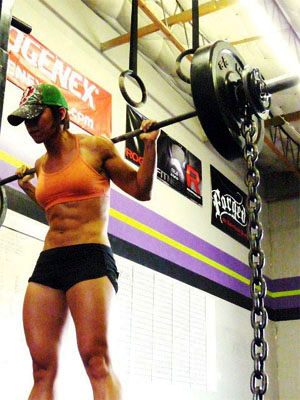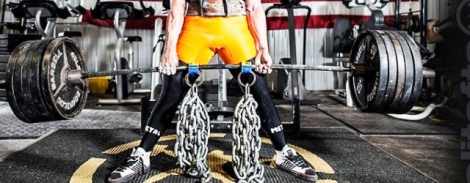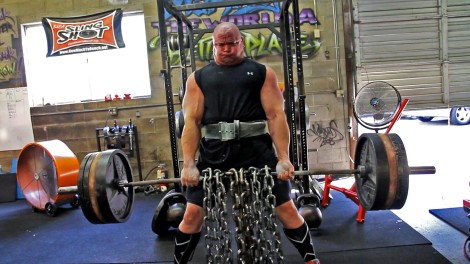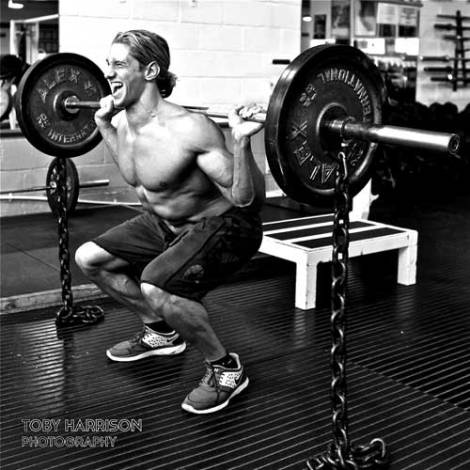By Louie Simmons
Because the human body is stronger at some positions than at others, we are limited as to the amount of weight we can use in a certain movement. For instance, you may be able to do a quarter squat with 600 lbs, but you may be able to only full squat 400 pounds. We all know through practical experience that while doing a simple curl, at the start of the movement, is very hard, whereas at the finish it is somewhat easier because of changing leverage. This problem was first addressed around 1900 by Max Herz. His solution was the oblong cam, which he patented. Years later, the Nautilus line of exercise equipment tried to solve this age-old problem, -in my opinion unsuccessfully.
One lifter’s strength will certainly be different from another lifter’s at the same joint angle. Let’s go back to the 1960s and power rack training. A power rack will, in one way, address this problem. For example, let’s say a lifter can deadlift 600 pounds off the floor. Utilizing a power rack, with the weight 2 inches off the floor he can pull, let’s say 625, and 4 inches off the floor, 650. By sitting the weight as high as 8 inches off the floor, he may be able to pull 750. In this manner, we have solved, at least partly, the problem of overloading, or providing adequate resistance as joint angles change.
However, it’s difficult for some to display this new found strength to flow from from pin height to pin height. This can be explained by the fact that it is very seldom that one’s body positions the same while pulling off the floor as it is while pulling off the rack. Isokinetics may be a partial solution, by maintaining a constant bar speed. But as with most machines, you must follow the path of the machine which is different from the path of a free weight. The path of a barbell is somewhat unpredictable at times. Another drawback is that prior to the start, as well as the finish, there is no load bearing on the lifter with this type of apparatus.

One lifter’s strength will certainly be different from another lifter’s at the same joint angle. Let’s go back to the 1960s and power rack training. A power rack will, in one way, address this problem. For example, let’s say a lifter can deadlift 600 pounds off the floor. Utilizing a power rack, with the weight 2 inches off the floor he can pull, let’s say 625, and 4 inches off the floor, 650. By sitting the weight as high as 8 inches off the floor, he may be able to pull 750. In this manner, we have solved, at least partly, the problem of overloading, or providing adequate resistance as joint angles change.
However, it’s difficult for some to display this new found strength to flow from from pin height to pin height. This can be explained by the fact that it is very seldom that one’s body positions the same while pulling off the floor as it is while pulling off the rack. Isokinetics may be a partial solution, by maintaining a constant bar speed. But as with most machines, you must follow the path of the machine which is different from the path of a free weight. The path of a barbell is somewhat unpredictable at times. Another drawback is that prior to the start, as well as the finish, there is no load bearing on the lifter with this type of apparatus.

Is there answer to the problem of how to overload or adequately load the body to match the body’s increase in leverage? Yes, there is. While many people call me for advice, others give me advice that I pass along. A gentleman, whose name I don’t remember, related to me some training he had done with chains. This was a few years ago, but we finally got around to using chains in an experiment with Amy Weisberger, a current World Champion, whose best total in 12 weeks went from 975 to 1025 as 123; Vanessa Schwenker, a current national champion. whose total went from 1030 to 1100 in 12 weeks; Tracy Tate, a novice lifter, increased her bench from 180 to 210; Dave Tate, her husband, a 308 with a previous total of 2028, who went from 782 to 830 in the squat, 540 to 585 in the bench, and 705 to 720 in the deadlift, for a total of 2135. After being stuck at 710 on a low box squat for 2 years, he made 765 after 6 workouts. Now with these examples in mind, here’s how we use chains in out training.
The chains are 5 feet long, 5/8 link size and 20 lbs each. They can be found at most industrial tool supply companies. For bench pressing, we will attach the chains to the bar so that when the arms are fully extended, half the chain is resting on the floor. After lowering the bar to the chest, all the chain is on the floor. By doing this, the original bar weight is maintained. Let’s go over this again. If you have 300 pounds on the bar plus 80 pounds of chains attached (2 sets of chains), with half the chain already on the floor, that adds up to 340 at the lockout position, but when the bar is lowered, all the chain is on the floor and the total weight on the bar is reduced to the original 300 at chest level. As you press, the weight gradually increases to 340.
Training with chains in this manner accomplishes three things. 1) We have maintained our original weight in order to use the correct percentage for explosive training. 2) We have overloaded the top portion of the lift, which normally does not receive sufficient work because of increased body leverage at this position. 3) A neurological response to build explosive strength is developed. This training will train you to drive to the top because you cannot slack off at the top phase as you used to.
The chains are 5 feet long, 5/8 link size and 20 lbs each. They can be found at most industrial tool supply companies. For bench pressing, we will attach the chains to the bar so that when the arms are fully extended, half the chain is resting on the floor. After lowering the bar to the chest, all the chain is on the floor. By doing this, the original bar weight is maintained. Let’s go over this again. If you have 300 pounds on the bar plus 80 pounds of chains attached (2 sets of chains), with half the chain already on the floor, that adds up to 340 at the lockout position, but when the bar is lowered, all the chain is on the floor and the total weight on the bar is reduced to the original 300 at chest level. As you press, the weight gradually increases to 340.
Training with chains in this manner accomplishes three things. 1) We have maintained our original weight in order to use the correct percentage for explosive training. 2) We have overloaded the top portion of the lift, which normally does not receive sufficient work because of increased body leverage at this position. 3) A neurological response to build explosive strength is developed. This training will train you to drive to the top because you cannot slack off at the top phase as you used to.
Here’s Mark “Smelly” Bell doing what he does best.
Those who bench press 400 pounds or less should use 40 pounds of chain; those who bench over 500 should use 80 pounds of chain. Those in between should experiment with both amounts and aim for adequate bar speed. Remember, half the chain should rest on the floor when the bar is racked.
Lifters who have a sticking point at or slightly above the knees in the deadlift will also find great benefit from using chains. Attach the chains to the bar with a lightweight chain to adjust where the heavy chain will leave the floor and contribute to the weight on the bar.
Tom Waddle uses 405-455 of regular bar weight on the deadlift bar. To that he will add up to 200 pounds of chain. As he lifts the 405 it gradually turns into 605 as the chains leave the floor.
The chains compensate for added leverage near the lockout. If you are weak at the top, this will solve your problem. Also it will develop starting strength. Because the chains make it more difficult to press as the bar ascends, you will instinctively try to accelerate the bar from start to finish.
The effects of special training normally occur in 2-4 weeks, but to my surprise, the training effect with chains is immediate.
As an experiment, we loaded the squat bar to 415 and did 2 reps. Next, a set of chains was added. They were attached so that all the chain weight was on the bar at the top, of 455, and half was unloaded at the bottom, or 435. Four additional sets were done, for a total of five with 415 or more. On set 6, two sets of chains were placed on the bar; top weight 495, bottom weight 455. On set 7, three sets of chains were used; top weight 535, bottom weight 475. Set 8, four sets of chains were used: top weight 575, bottom weight 495. Set 9, five sets of chains were used; top weight 615, bottom weight 515. These sets were done with 50 second rest periods. Next, we removed all the chains so the bar was reduced to the original 415. The box, which was already an inch below parallel, was lowered another inch. Four more sets were done. To our surprise, they were more explosive than our first sets with 415.
After 13 sets with 50 second rest periods, we were actually more explosive because of the chains. This immediate benefit is unheard of with conventional training.
I don’t sell chains, but I hope you buy this idea. It is one of the most effective ways to train that I have encountered. The chains will build starting strength and overload the body at the top of all three lifts, where due to added leverage, the muscles receive little work compared to the bottom portion of the lift. At the bottom, the chains work as a lightening device, by enabling one to handle the most weight at any one position of the lift.
I am passing this Westside Secret on to you in the hopes of helping you reach your goals, no matter what they may be.
Tom Waddle uses 405-455 of regular bar weight on the deadlift bar. To that he will add up to 200 pounds of chain. As he lifts the 405 it gradually turns into 605 as the chains leave the floor.
The chains compensate for added leverage near the lockout. If you are weak at the top, this will solve your problem. Also it will develop starting strength. Because the chains make it more difficult to press as the bar ascends, you will instinctively try to accelerate the bar from start to finish.
The effects of special training normally occur in 2-4 weeks, but to my surprise, the training effect with chains is immediate.
As an experiment, we loaded the squat bar to 415 and did 2 reps. Next, a set of chains was added. They were attached so that all the chain weight was on the bar at the top, of 455, and half was unloaded at the bottom, or 435. Four additional sets were done, for a total of five with 415 or more. On set 6, two sets of chains were placed on the bar; top weight 495, bottom weight 455. On set 7, three sets of chains were used; top weight 535, bottom weight 475. Set 8, four sets of chains were used: top weight 575, bottom weight 495. Set 9, five sets of chains were used; top weight 615, bottom weight 515. These sets were done with 50 second rest periods. Next, we removed all the chains so the bar was reduced to the original 415. The box, which was already an inch below parallel, was lowered another inch. Four more sets were done. To our surprise, they were more explosive than our first sets with 415.
After 13 sets with 50 second rest periods, we were actually more explosive because of the chains. This immediate benefit is unheard of with conventional training.
I don’t sell chains, but I hope you buy this idea. It is one of the most effective ways to train that I have encountered. The chains will build starting strength and overload the body at the top of all three lifts, where due to added leverage, the muscles receive little work compared to the bottom portion of the lift. At the bottom, the chains work as a lightening device, by enabling one to handle the most weight at any one position of the lift.
I am passing this Westside Secret on to you in the hopes of helping you reach your goals, no matter what they may be.
Courtesy of Louie Simmons and Westside Barbell



Комментариев нет:
Отправить комментарий